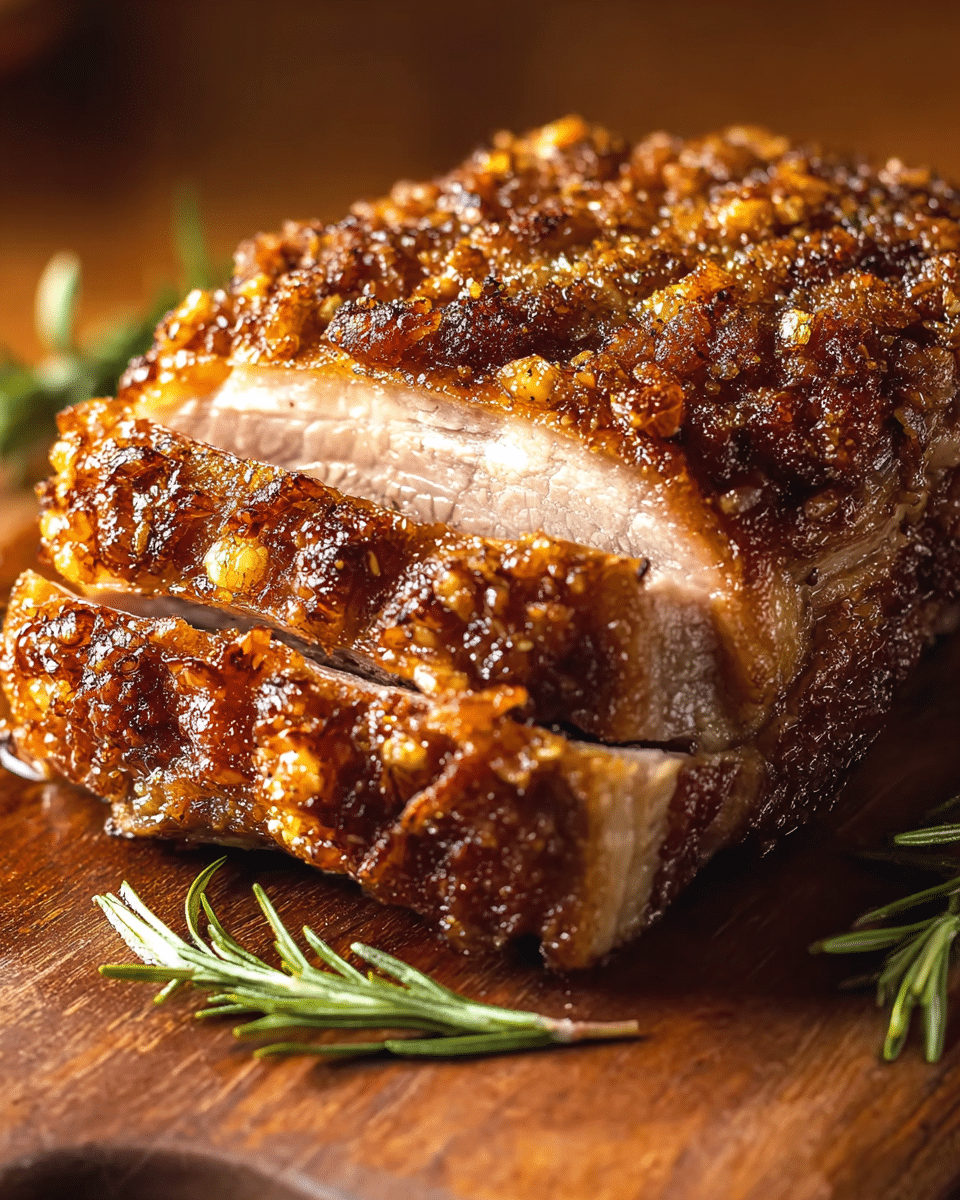This pork shoulder roast is a fantastic way to impress your guests with a savory, crispy, and flavorful dish. The key to success lies in the golden, crispy crackling that comes from roasting the pork shoulder at high heat, then slow-cooking it to tender perfection. Paired with aromatic garlic, rosemary, and fennel seeds (optional), this dish is a winner for both casual family meals and special occasions.
Full Recipe:
Ingredients
-
1 (3-4 lb) bone-in pork shoulder
-
2 tablespoons olive oil
-
2 teaspoons salt
-
1 teaspoon black pepper
-
1 tablespoon fennel seeds (optional)
-
3 cloves garlic, minced
-
2 sprigs rosemary, chopped
-
1/2 cup white wine or chicken broth
Directions
-
Preheat your oven to 450°F (230°C).
-
Pat the pork shoulder dry with paper towels. Score the skin with a sharp knife in a criss-cross pattern, making sure not to cut into the meat.
-
Rub the pork with olive oil, salt, pepper, fennel seeds (if using), garlic, and rosemary, ensuring it is well-coated.
-
Place the pork on a rack in a roasting pan, skin-side up. Roast for 20 minutes at 450°F (230°C) to start the crackling process.
-
Reduce the temperature to 325°F (160°C) and continue roasting for 3-4 hours, or until the pork is tender and the crackling is golden and crispy.
-
If the crackling isn’t crispy enough, turn the oven to broil for 5-10 minutes, watching closely to avoid burning.
-
Remove from the oven and let the pork rest for 15 minutes before slicing.
-
Serve with your favorite sides and enjoy!
Nutrients
-
Calories: Varies depending on serving size and sides
-
Servings: 6-8
Why Choose Pork Shoulder for Roasting
Pork shoulder is a great cut of meat for roasting because of its combination of fat and connective tissue. The fat helps keep the meat juicy and tender during the slow cooking process, while the connective tissue breaks down over time, contributing to the melt-in-your-mouth texture. This cut is ideal for long, slow roasting, which ensures the pork is tender and flavorful. When roasted properly, pork shoulder offers both crispy skin and succulent meat, making it a crowd-pleasing main course.
Additionally, pork shoulder is a more affordable option compared to other cuts like tenderloin or loin roast, yet it doesn’t sacrifice flavor or tenderness. Its forgiving nature when slow-cooked means that even beginners can prepare it with great success. Plus, the size of the roast means it’s perfect for feeding a larger group, making it an excellent choice for family gatherings or special occasions.
The Art of Achieving Perfect Crackling
One of the most exciting elements of a pork shoulder roast is the crispy crackling that forms on the skin. Achieving perfect crackling requires a combination of high heat and slow roasting. The process begins with scoring the skin in a criss-cross pattern, which allows the heat to penetrate and helps render the fat beneath the skin. The high initial roasting temperature, usually 450°F (230°C), kick-starts the crackling process, giving the skin its golden color and crispy texture.
However, the key to success doesn’t just lie in the initial high heat. After the first blast of heat, the temperature is reduced to around 325°F (160°C) to allow the meat to cook slowly and evenly. During this time, the fat renders, ensuring that the meat remains juicy and tender while the skin crisps up. If the crackling is not as crispy as you would like, a brief stint under the broiler at the end of cooking can help achieve that perfect texture.
The Role of Aromatics in Flavoring Pork Shoulder
While the crackling steals the spotlight, the flavor of the pork shoulder is equally important. Aromatics like garlic, rosemary, and fennel seeds (optional) bring depth to the meat, complementing the richness of the pork without overpowering it. Garlic is a timeless seasoning that adds a savory, aromatic element, while rosemary’s pine-like fragrance gives the dish an earthy and refreshing undertone.
Fennel seeds, though optional, can enhance the pork with a hint of sweetness and a subtle licorice flavor, which pairs beautifully with the richness of the meat. These simple ingredients infuse the pork as it roasts, creating a harmony of flavors that make each bite satisfying. The combination of garlic, rosemary, and fennel seeds creates an aromatic profile that complements the crispy crackling, making every bite of the roast a delightful experience.
Wine or Broth for Moisture and Flavor
The addition of white wine or chicken broth to the roasting pan is a crucial step in ensuring that the pork shoulder remains juicy and flavorful. As the pork roasts, the liquid evaporates and combines with the rendered fat to create a flavorful base that can be used to make a sauce or gravy. The wine or broth also helps to keep the meat moist during the long roasting process, preventing it from drying out.
White wine brings a slight acidity and brightness to the dish, which helps balance the richness of the pork. Chicken broth, on the other hand, adds a more subtle, savory depth to the dish. Both options contribute to the overall flavor profile of the roast and can be used to create a delicious sauce to serve alongside the pork.
Slow Roasting for Tender Perfection
Slow roasting is the key to achieving the tender, melt-in-your-mouth texture that pork shoulder is known for. After the initial high-heat roasting, the temperature is reduced to allow the meat to cook at a low and steady temperature. This slow roasting allows the collagen in the pork shoulder to break down, resulting in tender meat that pulls apart easily with a fork.
The long cooking time also gives the flavors more time to develop and intensify. The garlic, rosemary, and fennel seeds infuse the meat deeply, creating a flavor profile that is savory, aromatic, and full of depth. As the pork roasts, it becomes incredibly juicy, and the fat renders, making the meat flavorful and moist. The combination of tender meat and crispy crackling creates a delightful contrast that is the hallmark of a perfect pork shoulder roast.
Serving Suggestions and Pairing Ideas
A pork shoulder roast is a hearty and flavorful dish that pairs well with a variety of sides. Traditional accompaniments like mashed potatoes, roasted vegetables, and gravy are always a winning combination. The richness of the pork pairs beautifully with the creamy texture of mashed potatoes, and the crispy crackling adds a nice contrast to the soft vegetables.
For a more refined presentation, consider pairing the roast with roasted Brussels sprouts, caramelized onions, or a tangy apple slaw. The slight bitterness of Brussels sprouts balances the richness of the pork, while caramelized onions bring a touch of sweetness that complements the savory flavors. A crisp apple slaw adds a refreshing, tangy element that contrasts nicely with the richness of the meat.
If you’re serving the pork shoulder at a more casual gathering, try offering a variety of sides like baked beans, cornbread, or a simple green salad. The versatility of pork allows it to be paired with a wide range of flavors, so you can get creative with your sides based on your preferences or the season.
Leftovers and Creative Uses
One of the best parts about a pork shoulder roast is the leftovers. After a big meal, you can use the remaining pork in a variety of dishes. The tender, juicy meat can be shredded and used in tacos, sandwiches, or wraps. It also makes an excellent filling for a savory pie or a hearty stew. The flavorful drippings from the roasting pan can be used to make a rich gravy or sauce, further enhancing the flavor of any leftovers.
Shredded pork is also a great addition to salads, offering a protein-packed topping that adds flavor and texture. Whether you use the leftovers in soups, salads, or sandwiches, the possibilities are endless, making this roast not only a satisfying meal but also a great way to stretch your ingredients further.
Conclusion
In conclusion, a pork shoulder roast with crispy crackling is a dish that brings together the best of both worlds: tender, juicy meat and a crispy, flavorful skin. The combination of slow roasting and high-heat crackling creates a meal that is both comforting and impressive, perfect for family dinners or special occasions. With the right seasonings, such as garlic, rosemary, and fennel seeds, this dish offers a rich, aromatic flavor that enhances the natural goodness of the pork. Whether you’re serving it with traditional sides or exploring new accompaniments, this pork shoulder roast is sure to become a favorite in your cooking repertoire.






